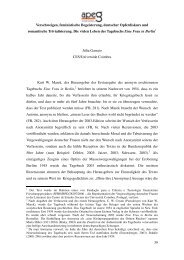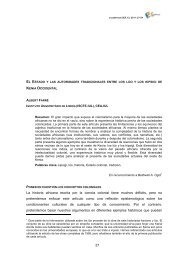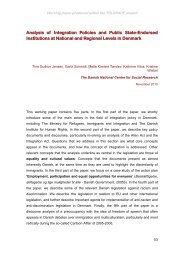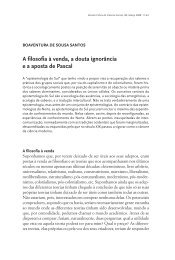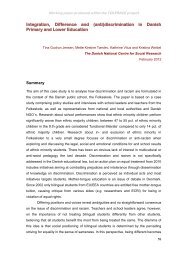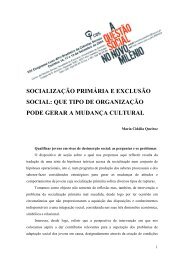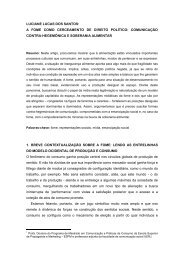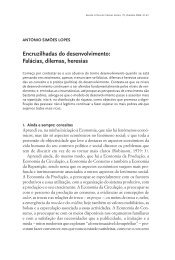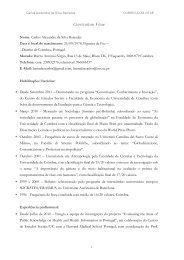The Instrumentalization of Sexual Violence in German Cold War Anti ...
The Instrumentalization of Sexual Violence in German Cold War Anti ...
The Instrumentalization of Sexual Violence in German Cold War Anti ...
You also want an ePaper? Increase the reach of your titles
YUMPU automatically turns print PDFs into web optimized ePapers that Google loves.
RCCS Annual Review<br />
5 (2013)<br />
Issue no. 5<br />
................................................................................................................................................................................................................................................................................................<br />
Júlia Garraio<br />
Hordes <strong>of</strong> Rapists: <strong>The</strong><br />
<strong>Instrumentalization</strong> <strong>of</strong> <strong>Sexual</strong> <strong>Violence</strong><br />
<strong>in</strong> <strong>German</strong> <strong>Cold</strong> <strong>War</strong> <strong>Anti</strong>-Communist<br />
Discourses<br />
................................................................................................................................................................................................................................................................................................<br />
<strong>War</strong>n<strong>in</strong>g<br />
<strong>The</strong> contents <strong>of</strong> this site is subject to the French law on <strong>in</strong>tellectual property and is the exclusive property <strong>of</strong> the<br />
publisher.<br />
<strong>The</strong> works on this site can be accessed and reproduced on paper or digital media, provided that they are strictly used<br />
for personal, scientific or educational purposes exclud<strong>in</strong>g any commercial exploitation. Reproduction must necessarily<br />
mention the editor, the journal name, the author and the document reference.<br />
Any other reproduction is strictly forbidden without permission <strong>of</strong> the publisher, except <strong>in</strong> cases provided by legislation<br />
<strong>in</strong> force <strong>in</strong> France.<br />
Revues.org is a platform for journals <strong>in</strong> the humanites and social sciences run by the CLEO, Centre for open electronic<br />
publish<strong>in</strong>g (CNRS, EHESS, UP, UAPV).<br />
................................................................................................................................................................................................................................................................................................<br />
Electronic reference<br />
Júlia Garraio, « Hordes <strong>of</strong> Rapists: <strong>The</strong> <strong>Instrumentalization</strong> <strong>of</strong> <strong>Sexual</strong> <strong>Violence</strong> <strong>in</strong> <strong>German</strong> <strong>Cold</strong> <strong>War</strong> <strong>Anti</strong>-Communist<br />
Discourses », RCCS Annual Review [Onl<strong>in</strong>e], 5 | 2013, Onl<strong>in</strong>e s<strong>in</strong>ce 01 October 2013, connection on 27 November<br />
2013. URL : http://rccsar.revues.org/476 ; DOI : 10.4000/rccsar.476<br />
Publisher: Centro de Estudos Sociais da Universidade de Coimbra<br />
http://rccsar.revues.org<br />
http://www.revues.org<br />
Document available onl<strong>in</strong>e on: http://rccsar.revues.org/476<br />
This PDF document was generated by the journal.<br />
© CES
RCCS Annual Review, 5, October 2013: 46-63<br />
Júlia Garraio<br />
Center for Social Studies, University <strong>of</strong> Coimbra, Portugal<br />
Hordes <strong>of</strong> Rapists: <strong>The</strong> <strong>Instrumentalization</strong> <strong>of</strong> <strong>Sexual</strong> <strong>Violence</strong> <strong>in</strong> <strong>German</strong> <strong>Cold</strong> <strong>War</strong> <strong>Anti</strong>-<br />
Communist Discourses *<br />
In <strong>German</strong> <strong>Cold</strong> <strong>War</strong> anti-communist discourses, the image <strong>of</strong> the Red Army as a “horde <strong>of</strong><br />
rapists” worked as a strategy <strong>of</strong> exclusion <strong>in</strong> the construction <strong>of</strong> a national identity based on<br />
“Western values.” This paper analyzes the ideological dimension <strong>of</strong> the stereotypes <strong>of</strong> raped<br />
women and constructions <strong>of</strong> mascul<strong>in</strong>ity <strong>in</strong> two emblematic texts about the flight and<br />
expulsion <strong>of</strong> <strong>German</strong>s from Eastern and Central Europe, and an anti-communist American<br />
propaganda novel. <strong>The</strong> mass rapes <strong>of</strong> <strong>German</strong> women <strong>in</strong> the context <strong>of</strong> World <strong>War</strong> II were<br />
signified as the result <strong>of</strong> “Asian barbarism” and communism. <strong>The</strong> <strong>in</strong>strumentalization <strong>of</strong><br />
wartime rapes, by demoniz<strong>in</strong>g the Soviet Union, fostered the two pillars <strong>of</strong> foreign policy <strong>in</strong> the<br />
Federal Republic: European <strong>in</strong>tegration and the transatlantic alliance.<br />
Keywords: anti-communism; Adenauer era; Flucht und Vertreibung [flight and expulsion];<br />
sexual violence; xenophobia.<br />
Post-1945 <strong>German</strong>y is probably one <strong>of</strong> the places where the ideological rivalries and tensions<br />
<strong>of</strong> the <strong>Cold</strong> <strong>War</strong> played a greater role <strong>in</strong> determ<strong>in</strong><strong>in</strong>g the shape <strong>of</strong> states and national<br />
identities. <strong>The</strong> Adenauer era (1949-1963) may be summarized as a conservative period<br />
dur<strong>in</strong>g which the country gradually jo<strong>in</strong>ed Western political, economic and military<br />
organizations. Under the leadership <strong>of</strong> Chancellor Konrad Adenauer (1876-1967), the Federal<br />
Republic <strong>of</strong> <strong>German</strong>y strived to w<strong>in</strong> the confidence <strong>of</strong> the Allies and thus make room for<br />
itself among Western nations. <strong>The</strong> country’s jo<strong>in</strong><strong>in</strong>g <strong>of</strong> NATO <strong>in</strong> 1955, as well as its<br />
rearmament, and the emergence <strong>of</strong> an ideal <strong>of</strong> mascul<strong>in</strong>ity strongly l<strong>in</strong>ked to a supposedly<br />
non-aggressive militarism, must be understood <strong>in</strong> the light <strong>of</strong> the nation’s re<strong>in</strong>vention <strong>of</strong><br />
itself as part <strong>of</strong> the West. 1 <strong>Anti</strong>-communism was central to this process <strong>of</strong> formation <strong>of</strong> the<br />
Federal Republic. Eric Weitz (2001: 220-22) observes that Adenauer’s deep distrust and fear<br />
* Article published <strong>in</strong> RCCS 96 (March 2012).<br />
<strong>The</strong> present paper is based on research carried out as part <strong>of</strong> the FCT-funded postdoctoral project on “<strong>The</strong><br />
Memory <strong>of</strong> Suffer<strong>in</strong>g: Representations <strong>of</strong> violence <strong>in</strong> <strong>German</strong> literature about the Second World <strong>War</strong>"<br />
(SFRH/BPD/28207/2006). My work on the representation <strong>of</strong> sexual violence benefited greatly from my<br />
research as a member <strong>of</strong> the SVAC (“<strong>Sexual</strong> <strong>Violence</strong> <strong>in</strong> Armed Conflict“) network<br />
(http://www.warandgender.net/).<br />
1 See, <strong>in</strong> this context, some <strong>of</strong> the research conducted by Robert Moeller. In his work on <strong>German</strong> popular<br />
c<strong>in</strong>ema <strong>of</strong> the 1950s, he analyzes the way <strong>in</strong> which, after the military collapse and the discredit <strong>of</strong> the sort <strong>of</strong><br />
“racially superior” mascul<strong>in</strong>ity promoted by the Third Reich, the young state set itself to build an ideal <strong>of</strong><br />
“morally superior” mascul<strong>in</strong>ity: that <strong>of</strong> the law-abid<strong>in</strong>g citizen who does not partake <strong>of</strong> nationalist, expansionist<br />
obsessions, but, when under threat, is capable <strong>of</strong> tak<strong>in</strong>g up arms to defend family and country (Moeller, 2001:<br />
123ss.; Moeller, 2006b).<br />
46
RCCS Annual Review, 5, October 2013<br />
<strong>The</strong> <strong>Instrumentalization</strong> <strong>of</strong> <strong>Sexual</strong> <strong>Violence</strong> <strong>in</strong> <strong>German</strong> <strong>Cold</strong> <strong>War</strong> <strong>Anti</strong>-Communist Discourses<br />
<strong>of</strong> communism were the reason for his emphatic defense <strong>of</strong> the Transatlantic Alliance, thus<br />
mak<strong>in</strong>g <strong>German</strong> reunification hard to achieve <strong>in</strong> the context <strong>of</strong> the <strong>Cold</strong> <strong>War</strong>. <strong>The</strong><br />
Chancellor’s view <strong>of</strong> the Soviet Union as the emblem <strong>of</strong> the worst that the age had to <strong>of</strong>fer –<br />
from Marxism-Len<strong>in</strong>ism to totalitarianism, pan-Slavism and atheism – was <strong>in</strong> fact widely<br />
shared <strong>in</strong> the public sphere <strong>of</strong> the young state, bolstered by the SPD’s 2 traditional animosity<br />
toward the communists.<br />
Dictated by the desire for closer ties with the West, this foreign policy coexisted with<br />
strong, East-lean<strong>in</strong>g electoral pressure at the domestic level. I allude to the Vertriebene, i.e.,<br />
the expellees from the territories lost by <strong>German</strong>y <strong>in</strong> the war (East Prussia, Silesia,<br />
Pomerania) and from its neighbor<strong>in</strong>g countries (Czechoslovakia, the Baltic states, etc.). 3<br />
<strong>The</strong>se <strong>German</strong>s, who made up about 16% <strong>of</strong> the population <strong>of</strong> the Federal Republic, were<br />
organized <strong>in</strong>to powerful leagues and associations and rose to be an extremely strong<br />
pressure group, prov<strong>in</strong>g <strong>in</strong>strumental <strong>in</strong> the conservatives’ consecutive victories. Until as late<br />
as 1969 there was a government m<strong>in</strong>istry solely devoted to them, 4 and they managed to<br />
have one <strong>of</strong> their major claims <strong>in</strong>cluded <strong>in</strong> the political debate: the recovery <strong>of</strong> their homes,<br />
which meant challeng<strong>in</strong>g the borders that had emerged from the war. 5 Adenauer’s<br />
governments successfully navigated this seem<strong>in</strong>g contradiction between a West-oriented<br />
foreign policy and a constituency that had its sights set on the East. Conditions were created<br />
for the expellees to start anew <strong>in</strong> the young republic, and steps were taken to get them to<br />
view the State as their new Heimat [homeland]: significant government aid to promote their<br />
economic welfare, a political discourse on the Federal Republic as the home <strong>of</strong> all <strong>German</strong>s,<br />
2 Sozialdemokratische Partei Deutschlands – the Social Democratic Party <strong>of</strong> <strong>German</strong>y.<br />
3 <strong>The</strong> word Vertriebene is closely l<strong>in</strong>ked to the concept <strong>of</strong> Flucht und Vertreibung [flight and expulsion], which<br />
designates one <strong>of</strong> the greatest migrations <strong>in</strong> human history (late 1944 through 1949) and on which there is an<br />
extensive literature. <strong>The</strong> Soviet <strong>of</strong>fensive <strong>of</strong> 1945 caused a massive flight <strong>of</strong> <strong>German</strong>s to the West. After the<br />
war, several regions <strong>in</strong> Central and Eastern Europe witnessed the violent expulsion <strong>of</strong> their <strong>German</strong><br />
communities. Allied decisions <strong>in</strong> favor <strong>of</strong> redesign<strong>in</strong>g the eastern borders (whereby <strong>German</strong>y was to lose a<br />
significant part <strong>of</strong> its territory) and <strong>of</strong> ethnically homogeneous states also contributed to the expulsion <strong>of</strong><br />
millions <strong>of</strong> <strong>German</strong>s dur<strong>in</strong>g the second half <strong>of</strong> the 1940s. <strong>The</strong> experience <strong>of</strong> flight and expulsion became one <strong>of</strong><br />
the most controversial sites <strong>of</strong> memory <strong>in</strong> <strong>German</strong> culture (see, e.g., Hahn and Hahn, 2003).<br />
4 Bundesm<strong>in</strong>isterium für Vertriebene, Flüchtl<strong>in</strong>ge und Kriegsgeschädigte – M<strong>in</strong>istry <strong>of</strong> the Expellees, Refugees<br />
and <strong>War</strong> Victims.<br />
5 This issue was a common concern <strong>of</strong> the ma<strong>in</strong> political parties at the time, as ev<strong>in</strong>ced by several election<br />
posters show<strong>in</strong>g maps <strong>of</strong> <strong>German</strong>y with 1937 borders and the caption “Das ganze Deutschland soll es se<strong>in</strong>” – “It<br />
has to be all <strong>of</strong> <strong>German</strong>y.” (A 1949 CDU poster can be seen at http://www.wahlen-<br />
98.de/HTML/ARCHIV/AFSETTIMELINE.HTM; a 1948 SPD poster is available at http://www.museen-<br />
sh.de/ml/digi_e<strong>in</strong>zBild.php?pi=146_54-1996&<strong>in</strong>st=146&mab_id=146&nameInst=Stadtmuseum%20-<br />
%20<strong>War</strong>leberger%20H<strong>of</strong>&page=7&action=vonsuche&r=82). With Willy Brandt’s Ostpolitik, the SPD moved<br />
away from these claims, which came to a f<strong>in</strong>al end with the 1990 Unification Treaty.<br />
47
RCCS Annual Review, 5, October 2013<br />
<strong>The</strong> <strong>Instrumentalization</strong> <strong>of</strong> <strong>Sexual</strong> <strong>Violence</strong> <strong>in</strong> <strong>German</strong> <strong>Cold</strong> <strong>War</strong> <strong>Anti</strong>-Communist Discourses<br />
<strong>in</strong>corporation <strong>of</strong> the memory <strong>of</strong> the lost East <strong>in</strong>to the national identity, good <strong>of</strong>ficial relations<br />
with the leagues and support for their cultural activities. No doubt political leaders knew<br />
that there was no turn<strong>in</strong>g back: with the sign<strong>in</strong>g <strong>of</strong> the Potsdam Agreement on 2 August<br />
1945, the Western Allies had sanctioned the redraw<strong>in</strong>g <strong>of</strong> borders and population transfer as<br />
a way <strong>of</strong> prevent<strong>in</strong>g tensions <strong>in</strong> the future. Government policies to provide support to the<br />
expellees may thus be seen as a way <strong>of</strong> alleviat<strong>in</strong>g that loss. Adenauer’s famous visit to<br />
Moscow <strong>in</strong> 1955 has all the signs <strong>of</strong> this course <strong>of</strong> action. <strong>The</strong> goal <strong>of</strong> this historical trip was<br />
not to discuss borders or the return <strong>of</strong> the expellees, but rather an issue regard<strong>in</strong>g which<br />
<strong>German</strong> public op<strong>in</strong>ion felt very strongly at the time: the liberation <strong>of</strong> the <strong>German</strong> soldiers<br />
still held captive by the Soviets. As far as <strong>of</strong>ficial discourse was concerned, the success <strong>of</strong> this<br />
mission was decisive <strong>in</strong> portray<strong>in</strong>g the Federal Republic as the homeland <strong>of</strong> all <strong>German</strong>s.<br />
<strong>The</strong> purpose <strong>of</strong> the present paper is to clarify one aspect <strong>of</strong> the abovementioned seem<strong>in</strong>g<br />
contradiction between a West-oriented foreign policy and a constituency whose <strong>in</strong>terests lay<br />
to the East. Based on discourses about the mass rape <strong>of</strong> <strong>German</strong> women by Soviet soldiers 6<br />
– a key experience <strong>of</strong> flight and expulsion – I will attempt to show the way <strong>in</strong> which the<br />
memory <strong>of</strong> what the expellees went through tended to re<strong>in</strong>force the two pillars <strong>of</strong> the<br />
Federal Republic’s foreign policy <strong>in</strong> the context <strong>of</strong> the <strong>Cold</strong> <strong>War</strong>: European <strong>in</strong>tegration and<br />
the transatlantic alliance. I will use two emblematic, expulsion-related texts to analyze the<br />
way <strong>in</strong> which the image <strong>of</strong> the Soviet rapist was conducive, <strong>in</strong> that particular context, to the<br />
construction <strong>of</strong> a certa<strong>in</strong> pro-European and pro-Western <strong>German</strong> identity. <strong>The</strong> first <strong>of</strong> these<br />
two works, Martyrium und Heldentum Ostdeutscher Frauen. E<strong>in</strong> Ausschnitt aus der<br />
Schlesischen Passion 1945/4 (1954) [<strong>The</strong> Martyrdom and Heroism <strong>of</strong> the Women <strong>of</strong> East<br />
<strong>German</strong>y: An excerpt from the Silesian passion, 1945-1946], was written by Johannes Kaps, a<br />
prom<strong>in</strong>ent theologian <strong>in</strong> Catholic circles and <strong>in</strong> the Bavaria-based community <strong>of</strong> expellees,<br />
who strived to raise awareness <strong>in</strong> the “Christian West” about the expulsion <strong>of</strong> <strong>German</strong>s as a<br />
result <strong>of</strong> the war. 7 <strong>The</strong> volume <strong>in</strong> question is a collection <strong>of</strong> stories <strong>of</strong> sexual violence, kill<strong>in</strong>gs<br />
6 For studies on sexual violence perpetrated by the Soviet Army aga<strong>in</strong>st <strong>German</strong> women, see, among others,<br />
Naimark (1995) and von Münch (2009).<br />
7 Johannes Kaps (Breslau, 1906 – Munich, 1959) came from a Catholic family and was orda<strong>in</strong>ed priest <strong>in</strong> 1935.<br />
In 1939, shortly after the outbreak <strong>of</strong> World <strong>War</strong> II, he returned to Breslau. Accord<strong>in</strong>g to Hans-Ludwig Abmeier,<br />
Kaps seems to have devoted himself to the cause <strong>of</strong> the release <strong>of</strong> persecuted priests and aga<strong>in</strong>st the<br />
deportation <strong>of</strong> Jews and “cross-breeds” (but Abmeier adds that, because <strong>of</strong> the destruction <strong>of</strong> war, there are<br />
very few documents to confirm it). A witness <strong>of</strong> the capitulation <strong>of</strong> Breslau on 6 May 1945, Kaps gave testimony<br />
<strong>of</strong> the atrocities committed aga<strong>in</strong>st the <strong>German</strong> population. In August 1945 he left the city and took refuge <strong>in</strong><br />
the West, giv<strong>in</strong>g an account <strong>of</strong> the conditions <strong>of</strong> extreme deprivation <strong>of</strong> the <strong>German</strong> population <strong>of</strong> Silesia, after<br />
48
RCCS Annual Review, 5, October 2013<br />
<strong>The</strong> <strong>Instrumentalization</strong> <strong>of</strong> <strong>Sexual</strong> <strong>Violence</strong> <strong>in</strong> <strong>German</strong> <strong>Cold</strong> <strong>War</strong> <strong>Anti</strong>-Communist Discourses<br />
and hardship that bear witness to an engagement, from a <strong>German</strong> Catholic po<strong>in</strong>t <strong>of</strong> view,<br />
with the rape <strong>of</strong> <strong>German</strong> women. 8 <strong>The</strong> second text, Ostpreußisches Tagebuch.<br />
Aufzeichnungen e<strong>in</strong>es Arztes aus den Jahren 1945-1947 [Prussian Diary. A Physician’s Notes<br />
1945-1947], 9 is by Hans Graf von Lehndorff, the descendant <strong>of</strong> an <strong>in</strong>fluential Prussian family<br />
and a prom<strong>in</strong>ent figure <strong>in</strong> expellee circles. 10 Endorsed by the Federal Republic’s authorities,<br />
von Lehndorff’s journal was one <strong>of</strong> the most popular memoirs <strong>of</strong> expulsion <strong>of</strong> its time.<br />
F<strong>in</strong>ally, I will also argue that the image <strong>of</strong> the Soviet rapist runn<strong>in</strong>g through these expellee<br />
accounts ultimately plays a role that is similar to that <strong>of</strong> an American propaganda novel that<br />
was hugely successful <strong>in</strong> 1950s <strong>German</strong>y: <strong>The</strong> Big Rape (1951), by James Wakefield Burke. 11<br />
which he travelled to Rome to apprise Pope Pius XII <strong>of</strong> the situation. In the follow<strong>in</strong>g years he was very active <strong>in</strong><br />
provid<strong>in</strong>g support to the expellees now liv<strong>in</strong>g <strong>in</strong> the Federal Republic. As <strong>of</strong> 1952, he was the head <strong>of</strong> the<br />
Catholic Church’s Parish Register Services and <strong>of</strong> the Expellees Archive, <strong>in</strong> Munich [Katholischen<br />
Kirchenbuchamtes Archivs und für Heimatvertriebene]. With a view to <strong>in</strong>ternationaliz<strong>in</strong>g the expellees’ issue,<br />
along the goals set forth by then M<strong>in</strong>ister <strong>of</strong> Expellees Hans Lukaschek, Kaps’s trilogy on Silesia was translated<br />
<strong>in</strong>to English, French, Italian, Spanish and Portuguese dur<strong>in</strong>g the 1950s (Abmeier, 2000/2001: 183-185). <strong>The</strong><br />
English translation, by Gladys H. Hart<strong>in</strong>ger, was first published <strong>in</strong> Munich by Christ Unterwegs, <strong>in</strong> 1955.<br />
8 This is the clos<strong>in</strong>g volume <strong>of</strong> a trilogy on the end <strong>of</strong> <strong>German</strong> Silesia. Two volumes had already been published:<br />
Vom Sterben Schlesischer Priester 1945/6 [<strong>The</strong> Martyrdom <strong>of</strong> Silesian priests 1945-46], <strong>in</strong> 1950, and Tragödie<br />
Schlesiens 1945/6 <strong>in</strong> Dokumenten [<strong>The</strong> Tragedy <strong>of</strong> Silesia 1945/6 – A documentary account], <strong>in</strong> 1952/53. Most<br />
<strong>of</strong> the accounts <strong>in</strong> the 1954 volume were collected <strong>in</strong> the early 1950s for Kaps’s unpublished Beiträge zur<br />
Geschichte der Erzdiözese Breslau <strong>in</strong> den Schicksalsjahren 1945 bis 1951 [Contributions to the history <strong>of</strong> the<br />
Archdiocese <strong>of</strong> Breslau <strong>in</strong> the fateful years <strong>of</strong> 1945-1951].<br />
9 <strong>The</strong> diary was orig<strong>in</strong>ally published <strong>in</strong> 1960 as part <strong>of</strong> a government project to collect documentary evidence<br />
on the expulsion <strong>of</strong> <strong>German</strong>s from Eastern and Central Europe [Dokumentation der Vertreibung der Deutschen<br />
aus Ost-Mitteleuropa]. <strong>The</strong> orig<strong>in</strong>al title <strong>of</strong> the diary was E<strong>in</strong> Bericht aus Ost-und Westpreussen 1945-1947 (A<br />
Report from Eastern and Western Prussia 1945-1947). In 1961 it was published autonomously (München:<br />
Biederste<strong>in</strong>) under its present title, and it went through numerous editions over the years. In the 1960s it was<br />
translated <strong>in</strong>to several languages. <strong>The</strong> English translation, entitled East Prussian Diary: A Journal <strong>of</strong> Faith, 1945-<br />
1947, was published <strong>in</strong> 1963.<br />
10 A member <strong>of</strong> an ancient l<strong>in</strong>e <strong>of</strong> Prussian nobility, Hans von Lehndorff (Graditz bei Torgau, 1910 – Bonn, 1987)<br />
is related to several important figures <strong>in</strong> twentieth century <strong>German</strong> history: his grandfather, Elard Januschauvon<br />
Oldenburg (1855-1937), was an <strong>in</strong>fluential member <strong>of</strong> the conservative camp dur<strong>in</strong>g the Weimar Republic,<br />
and He<strong>in</strong>rich Graf von Lehndorff-Ste<strong>in</strong>ort, who was executed <strong>in</strong> September 1944 for participat<strong>in</strong>g <strong>in</strong> the July 20<br />
conspiracy to assass<strong>in</strong>ate Hitler, was his cous<strong>in</strong>. Hans von Lehndorff studied medic<strong>in</strong>e and was runn<strong>in</strong>g a<br />
military hospital <strong>in</strong> Königsberg when the Red Army took the city. He fled to the West <strong>in</strong> 1947, and from the<br />
time <strong>of</strong> his arrival <strong>in</strong> the future FRG he kept l<strong>in</strong>ks with expellees’ organizations. In 1981 he was awarded the<br />
most prestigious prize given by East Prussia’s associations <strong>of</strong> expellees: the Preußenschild, awarded by<br />
Landmannschaft Ostpreußen (Hamburg).<br />
11 <strong>The</strong> texts analyzed <strong>in</strong> this article are <strong>in</strong> l<strong>in</strong>e with the ideological manipulation <strong>of</strong> sexual violence directed<br />
aga<strong>in</strong>st <strong>German</strong> women <strong>in</strong> World <strong>War</strong> II. Although the memory <strong>of</strong> these violations was particularly felt <strong>in</strong><br />
nationalist and anti-communist milieus and even <strong>in</strong> revisionist discourses, one should not associate the issue<br />
exclusively with these sectors, as it was also addressed by texts from many other quadrants. Thus we have the<br />
Russian testimonies to start with, namely by Lew Kopelew (the autobiography <strong>in</strong> which he tells <strong>of</strong> the violence<br />
committed by the Red Army aga<strong>in</strong>st the <strong>German</strong> people was published <strong>in</strong> the Federal Republic <strong>in</strong> 1976 under<br />
the title Aufbewahren für alle Zeit [To Be Preserved Forever], with an afterword by the writer He<strong>in</strong>rich Böll) and<br />
Alexander Solzhenitsyn (his memories <strong>of</strong> the atrocities aga<strong>in</strong>st the <strong>German</strong>s upon the conquest <strong>of</strong> East Prussia<br />
were the <strong>in</strong>spiration for Ostpreußische Nächte. E<strong>in</strong>e Dichtung <strong>in</strong> Versen [Prussian Nights. A Poem], published <strong>in</strong><br />
the Federal Republic also <strong>in</strong> 1976). On the <strong>German</strong> side there are a number <strong>of</strong> accounts, memoirs and even<br />
some literary texts whose ideological provenance differs from that <strong>of</strong> the texts analyzed <strong>in</strong> the present article<br />
49
RCCS Annual Review, 5, October 2013<br />
<strong>The</strong> <strong>Instrumentalization</strong> <strong>of</strong> <strong>Sexual</strong> <strong>Violence</strong> <strong>in</strong> <strong>German</strong> <strong>Cold</strong> <strong>War</strong> <strong>Anti</strong>-Communist Discourses<br />
<strong>The</strong> image <strong>of</strong> Asia or the East as the embodiment <strong>of</strong> a barbarian, dangerous and cruel<br />
Other is a recurrent one <strong>in</strong> the construction <strong>of</strong> European and Western identities. After the<br />
October Revolution, Russia (and, eventually, the Soviet Union) emerged as a catalyst for<br />
fears, the Eastern “monster” <strong>in</strong>carnate, as anti-communism gradually took on orientalist<br />
connotations. Bolshevism and Communism were not viewed as European or Western<br />
phenomena, but rather as the hallmarks <strong>of</strong> an alien counter-model. <strong>The</strong> <strong>German</strong> territory<br />
provides a paradigmatic illustration <strong>of</strong> this mean<strong>in</strong>g <strong>of</strong> Bolshevik Russia as the <strong>in</strong>carnation <strong>of</strong><br />
the absolute Other (see, for <strong>in</strong>stance, Ayçoberry, 2003; Moore, 2003). <strong>The</strong>se phobias<br />
associated with anticommunism existed <strong>in</strong> several European countries. In <strong>German</strong>y they ran<br />
throughout the 20 th century, and spearheaded some <strong>of</strong> the more salient cont<strong>in</strong>uities<br />
between the Third Reich and the Federal Republic. Horrid images <strong>of</strong> sexual violence were<br />
common <strong>in</strong> this context, as attested to by anti-Bolshevik Nazi propaganda, which never<br />
stopped to frighten people with the “hordes <strong>of</strong> Soviet rapists,” especially <strong>in</strong> the last months<br />
<strong>of</strong> the war. 12 As noted by At<strong>in</strong>a Grossmann, this is exactly where propaganda proved<br />
om<strong>in</strong>ous. And that, <strong>in</strong> turn, helps us understand the impact <strong>of</strong> these National Socialist<br />
discourses and imag<strong>in</strong>aries upon <strong>German</strong>y’s memory <strong>of</strong> defeat, as well as the country’s selfperception<br />
as a people <strong>of</strong> victims (1995: 113-117, 1998: 221-24).<br />
<strong>The</strong> propaganda <strong>of</strong> Adenauer’s conservative era made blatant use <strong>of</strong> the traumatic<br />
experience <strong>of</strong> the rape <strong>of</strong> <strong>German</strong> women by members <strong>of</strong> the Red Army to justify some <strong>of</strong> its<br />
political positions, which expla<strong>in</strong>s its portray<strong>in</strong>g <strong>of</strong> the Soviet Union <strong>in</strong> terms <strong>of</strong> an<br />
aggressive, repellent mascul<strong>in</strong>ity. 13 Let us consider a 1952 poster <strong>of</strong> the Volksbund für<br />
Frieden und Freiheit [People’s Union for Peace and Freedom], an organization first<br />
established <strong>in</strong> 1949. It alludes to rape us<strong>in</strong>g it as a metaphor for <strong>German</strong>-Soviet friendship,<br />
(see, for <strong>in</strong>stance, the 1966 novel Westend, by Annemarie Weber, or Christian Graf von Krockow’s 1988<br />
account Die Stunden der Frauen. Nach e<strong>in</strong>er Erzählung Libussa Fritz von-Krockow [Hour <strong>of</strong> the Women. Based<br />
on an oral narrative by Libussa Fritz-Krockow]). Most <strong>of</strong> the studies on the treatment <strong>of</strong> this topic <strong>in</strong> the context<br />
<strong>of</strong> <strong>German</strong> culture focus on BeFreier und Befreite [Liberators Take Liberties], a documentary about rape <strong>in</strong> 1945<br />
Berl<strong>in</strong> by fem<strong>in</strong>ist filmmaker Helke Sander. Made <strong>in</strong> 1992, the film met both with great popular success and<br />
full-blown controversy.<br />
12 <strong>The</strong> phobia <strong>of</strong> the “hordes <strong>of</strong> Mongolian savages,” eager to murder, pillage, destroy and rape, had been one<br />
<strong>of</strong> the fears most fostered and exploited by the National Socialist authorities to mobilize people for the fight<br />
aga<strong>in</strong>st the Soviet <strong>of</strong>fensive, especially after the Nemmersdorf massacre (October 1944), when <strong>German</strong> women<br />
and girls were brutally raped and murdered. Regard<strong>in</strong>g the use <strong>of</strong> racist stereotypes for demoniz<strong>in</strong>g the Soviet<br />
Union <strong>in</strong> pre-1945 <strong>German</strong>y (not just <strong>in</strong> National Socialist circles) and the image <strong>of</strong> the rapist soldier <strong>in</strong> wartime<br />
propaganda, see, for example, Ayçoberry (2003: 455-65) and Moore (2003: 31-42).<br />
13<br />
Thumbnails <strong>of</strong> some <strong>of</strong> these posters can be seen at http://userpage.fuberl<strong>in</strong>.de/roehrigw/lva/ws9596/texte/kk/dhm/bsp.html.<br />
Retrieved March 8, 2012.<br />
50
RCCS Annual Review, 5, October 2013<br />
<strong>The</strong> <strong>Instrumentalization</strong> <strong>of</strong> <strong>Sexual</strong> <strong>Violence</strong> <strong>in</strong> <strong>German</strong> <strong>Cold</strong> <strong>War</strong> <strong>Anti</strong>-Communist Discourses<br />
with the purpose <strong>of</strong> expos<strong>in</strong>g the rival <strong>German</strong> state as the <strong>of</strong>fspr<strong>in</strong>g <strong>of</strong> a female <strong>German</strong>y<br />
overpowered by a male Soviet Union. Elisabeth He<strong>in</strong>eman pays special attention to a poster<br />
<strong>of</strong> the conservative coalition CDU that reads “Ne<strong>in</strong>, Darum CDU” [No, therefore CDU], <strong>in</strong><br />
which the Soviet Union is portrayed as a threaten<strong>in</strong>g Asian man. Accord<strong>in</strong>g to He<strong>in</strong>eman, this<br />
type <strong>of</strong> imagery, which resonated with the age-old phobia <strong>of</strong> Genghis Khan’s “hordes <strong>of</strong><br />
rapists” and had figured so prom<strong>in</strong>ently <strong>in</strong> wartime propaganda, is a clear <strong>in</strong>dication <strong>of</strong> how<br />
sexual violence aga<strong>in</strong>st <strong>German</strong> women was used <strong>in</strong> the Federal Republic as an expression <strong>of</strong><br />
Asian barbarism and as a metaphor for the brutalization <strong>of</strong> <strong>German</strong>y and its Western<br />
Christian culture by communism (He<strong>in</strong>eman, 1996: 355, 367-73). In the public sphere,<br />
therefore, rape and violation were not recalled as acts <strong>of</strong> sexual violence aga<strong>in</strong>st women and<br />
young girls <strong>in</strong> the framework <strong>of</strong> armed conflicts marked by patriarchal cultures with a strong<br />
ethnic component. Instead, they were made <strong>in</strong>to political images that were firmly<br />
embedded <strong>in</strong> <strong>Cold</strong> <strong>War</strong> discourses. <strong>The</strong> two <strong>German</strong> texts I will now proceed to analyze,<br />
together with the novel <strong>The</strong> Big Rape, are perfect illustrations <strong>of</strong> this signification <strong>of</strong> sexual<br />
violence.<br />
Martyrs <strong>of</strong> Bolshevism<br />
In the preface to Kaps’s book, written by Joseph Ferche – who presents himself as the sole<br />
surviv<strong>in</strong>g bishop <strong>in</strong> Silesia to have witnessed firsthand the <strong>in</strong>vasion <strong>of</strong> the enemy from the<br />
East – the atrocities that fell upon the <strong>German</strong> people at the end <strong>of</strong> the war are presented as<br />
part <strong>of</strong> an ancient history <strong>of</strong> Christian suffer<strong>in</strong>g at the hands <strong>of</strong> the <strong>in</strong>fidels: “<strong>The</strong> aim <strong>of</strong> this<br />
book is to record for history the heroism shown by <strong>German</strong> women and girls dur<strong>in</strong>g the<br />
onslaught <strong>of</strong> the Bolshevik hordes, and to serve as a cautionary tale for the Christian West<br />
and the world as a whole” (Kaps, 1954: 7). 14<br />
In the words <strong>of</strong> the bishop, <strong>in</strong> the years 1945/46 Silesia resembled an arena <strong>of</strong> martyrs, a<br />
place where believers suffered harsh trials (ibidem: 7). Thus the book’s epigraph is a quote<br />
from the Roman Breviary allud<strong>in</strong>g to the Virg<strong>in</strong> and Martyr Sa<strong>in</strong>t Lucy: “If I am dishonoured<br />
aga<strong>in</strong>st my will, my chastity will secure for me a double crown <strong>of</strong> victory” (ibidem: 3). Maria<br />
Goretti, the twelve-year-old Catholic Italian girl who was killed <strong>in</strong> 1902 as a result <strong>of</strong><br />
attempted rape, and the ceremony <strong>of</strong> her canonization <strong>in</strong> 1950, play a crucial role <strong>in</strong> the<br />
<strong>in</strong>troduction. Goretti is presented as a forerunner <strong>of</strong> wartime <strong>German</strong> women: “In the East<br />
14 Translated from the <strong>German</strong>.<br />
51
RCCS Annual Review, 5, October 2013<br />
<strong>The</strong> <strong>Instrumentalization</strong> <strong>of</strong> <strong>Sexual</strong> <strong>Violence</strong> <strong>in</strong> <strong>German</strong> <strong>Cold</strong> <strong>War</strong> <strong>Anti</strong>-Communist Discourses<br />
we had hundreds <strong>of</strong> Marias Goretti: is there anyone who speaks <strong>of</strong> them?” (ibidem: 9). <strong>The</strong><br />
depositions themselves, gathered from <strong>German</strong> believers, <strong>in</strong>clud<strong>in</strong>g a large number <strong>of</strong><br />
priests and nuns, are framed by religious terms and imagery. 15 In order to f<strong>in</strong>d a language<br />
and categories for mak<strong>in</strong>g sense <strong>of</strong> their experience <strong>of</strong> the end <strong>of</strong> the war and <strong>of</strong> Soviet<br />
occupation, the expellees resort to the Christian imag<strong>in</strong>ary, as illustrated by the follow<strong>in</strong>g<br />
excerpts (the first by a nun, the second by a “young mother from Breslau”):<br />
<strong>The</strong> Russians lost all sense <strong>of</strong> shame. <strong>The</strong>y were hordes <strong>of</strong> Mongols <strong>of</strong> the worst k<strong>in</strong>d, as we<br />
were to learn later, with a satanic look on their faces. <strong>The</strong>n our martyrdom began […]. (ibidem:<br />
75)<br />
It must have been like this among the early Christians, a community joyful and true, noth<strong>in</strong>g<br />
fake about it. (ibidem: 126)<br />
<strong>The</strong> emphasis on sexual violence is used to demonize the Soviet Union as a polity that<br />
does away with the most basic social and moral norms when it brutally smashes the pillars <strong>of</strong><br />
patriarchal society and Christian morality: it respects neither female virg<strong>in</strong>ity nor marriage<br />
bonds, nor does it refra<strong>in</strong> from lust<strong>in</strong>g after the spouses <strong>of</strong> Christ. <strong>The</strong> amount <strong>of</strong> cases<br />
<strong>in</strong>volv<strong>in</strong>g the rape and murder <strong>of</strong> nuns, some <strong>of</strong> them told <strong>in</strong> the first person (e.g. Kaps 1954:<br />
43ff.), together with corpse desecration/violation (ibidem: 82), stand out as the epitome <strong>of</strong><br />
the lack <strong>of</strong> values, the civilizational chaos and the savagery <strong>of</strong> which the victors are accused<br />
<strong>in</strong> these testimonies. See, for <strong>in</strong>stance, the rape and kill<strong>in</strong>g <strong>of</strong> an eighty-five-year-old deafbl<strong>in</strong>d<br />
nun (ibidem: 90). <strong>The</strong> follow<strong>in</strong>g deposition summarizes the message that runs<br />
throughout the book, as it blames atheism and communism for sexual violence: “That is the<br />
great tragedy <strong>of</strong> the Russian people: once they were forcibly deprived <strong>of</strong> religion, the people<br />
did not know the seventh or the tenth commandment, nor the sixth and the n<strong>in</strong>th! Many<br />
women and girls were dishonored <strong>in</strong> a violent and most bestial manner” (Kaps, 1954: 99).<br />
<strong>The</strong>se acts <strong>of</strong> violence are imputed to the negation <strong>of</strong> God <strong>in</strong> the aftermath <strong>of</strong> the<br />
October Revolution. In this context where blame is p<strong>in</strong>ned on communism, the last few<br />
pages, devoted to the “good Slavs” – the Poles and Russians who protected <strong>German</strong> women<br />
– are <strong>of</strong> the utmost importance. In his <strong>in</strong>troduction to the second chapter, Kaps had already<br />
argued for the need to tell between a m<strong>in</strong>ority <strong>of</strong> Polish communists, who, led by hatred and<br />
15 <strong>The</strong> abundance <strong>of</strong> depositions by clergy and members <strong>of</strong> religious orders, as well as the ample use <strong>of</strong><br />
Christian imagery by the expellees, are primarily a direct consequence <strong>of</strong> the method <strong>of</strong> documentation<br />
adopted by Kaps, who moved mostly among church-go<strong>in</strong>g expellees from the Munich area.<br />
52
RCCS Annual Review, 5, October 2013<br />
<strong>The</strong> <strong>Instrumentalization</strong> <strong>of</strong> <strong>Sexual</strong> <strong>Violence</strong> <strong>in</strong> <strong>German</strong> <strong>Cold</strong> <strong>War</strong> <strong>Anti</strong>-Communist Discourses<br />
Soviet <strong>in</strong>fluence, participated <strong>in</strong> the rapes, and the majority <strong>of</strong> the Polish population,<br />
supposedly made up <strong>of</strong> good, God-fear<strong>in</strong>g people.<br />
<strong>The</strong> text’s silences and omissions are an immediate giveaway <strong>of</strong> the problematic nature <strong>of</strong><br />
sexual violence as a signifier <strong>of</strong> communism. In fact, no mention is made <strong>of</strong> the extremely<br />
high levels <strong>of</strong> sexual violence committed by the <strong>German</strong> troops <strong>in</strong> the East, 16 or <strong>of</strong> the rape<br />
<strong>of</strong> <strong>German</strong> women by members <strong>of</strong> the Western Allied Forces. 17 This has to do, to a certa<strong>in</strong><br />
extent, with the dual, Manichean way <strong>in</strong> which this phenomenon is viewed: s<strong>in</strong>ce sexual<br />
violence, accord<strong>in</strong>g to the text’s logic, is a hallmark <strong>of</strong> the non-believers, it cannot<br />
conceivably be practiced on a large scale by Christian nations. And given that the abuses<br />
suffered by Silesian <strong>German</strong>s are not analyzed as part <strong>of</strong> the spiral <strong>of</strong> violence caused by the<br />
war and the crimes <strong>in</strong>itiated by the <strong>German</strong> people <strong>in</strong> the political context <strong>of</strong> the attack on<br />
the Soviet Union, the <strong>German</strong> women who were raped tend to be perceived as the victims <strong>of</strong><br />
a conflict that goes beyond the framework <strong>of</strong> the Second World <strong>War</strong>. <strong>The</strong>se are stories about<br />
Christian girls and women who were abused by the Bolsheviks, where violence is framed, on<br />
the one hand, <strong>in</strong> a narrative <strong>of</strong> Christian persecution, and on the other <strong>in</strong> the fecund<br />
tradition <strong>of</strong> the Christian martyrs <strong>of</strong> chastity (Goretti, Sa<strong>in</strong>t Lucia and others). As a result, the<br />
Soviet Union is primarily seen as a scourge <strong>of</strong> believers, and rapes emerge as the recurrence<br />
<strong>of</strong> an ahistorical phenomenon: the fight <strong>of</strong> Evil versus Good, s<strong>in</strong> versus chastity, barbarism<br />
versus civilization. Both geographically and culturally, the borders are easy to draw: from the<br />
Bolshevik East (Asia) comes barbarism; the Christian West (Europe) is where Good dwells.<br />
<strong>The</strong>re, <strong>in</strong> Christian Europe, is where the <strong>German</strong> people supposedly belong.<br />
With<strong>in</strong> the framework <strong>of</strong> <strong>Cold</strong> <strong>War</strong> geopolitics and anticommunism, the aims <strong>of</strong> <strong>The</strong><br />
Martyrdom and Heroism <strong>of</strong> the Women <strong>of</strong> East <strong>German</strong>y are <strong>in</strong>extricable from a subtext that<br />
calls for the re-Christianization <strong>of</strong> Europe and which can be summed up by the f<strong>in</strong>al words <strong>of</strong><br />
one <strong>of</strong> the testimonies: “Almighty and k<strong>in</strong>dly God, give the Russians the grace <strong>of</strong> conversion<br />
and br<strong>in</strong>g peace to all peoples” (Kaps, 1954: 46). <strong>The</strong> allusions to the “good Slavs” should<br />
also be seen <strong>in</strong> this light. For Kaps, the gruesome war experiences had surely caused many<br />
on both sides to feel closer to the div<strong>in</strong>e, and that return to God was to be the force lead<strong>in</strong>g<br />
to future reconciliation and peace among the peoples <strong>of</strong> the world: “Let us then hope that<br />
the <strong>in</strong>nocent victims from Eastern <strong>German</strong>y have not suffered <strong>in</strong> va<strong>in</strong>, but rather laid the<br />
16 On sexual violence perpetrated dur<strong>in</strong>g the attack on the Soviet Union, see, e.g., Mühlhäuser (2010).<br />
17 On sexual violence by members <strong>of</strong> the U.S. military, see, e.g., Lilly (2007).<br />
53
RCCS Annual Review, 5, October 2013<br />
<strong>The</strong> <strong>Instrumentalization</strong> <strong>of</strong> <strong>Sexual</strong> <strong>Violence</strong> <strong>in</strong> <strong>German</strong> <strong>Cold</strong> <strong>War</strong> <strong>Anti</strong>-Communist Discourses<br />
foundations for a better Christian future for both <strong>German</strong>s and Slavs” (ibidem: 23). This<br />
desire to rechristianize Europe also had <strong>in</strong> m<strong>in</strong>d certa<strong>in</strong> social practices <strong>of</strong> the Federal<br />
Republic <strong>of</strong> <strong>German</strong>y. In his <strong>in</strong>troduction, Bishop Ferche writes that the sacrifices recounted<br />
<strong>in</strong> the book should be held up as an example at a time when so many <strong>German</strong> women lightly<br />
risked their honor (ibidem: 8). Throughout the text it becomes more and more obvious that<br />
re-Christianization is just another word for regulat<strong>in</strong>g moral behavior and sexual norms<br />
(disapprov<strong>in</strong>g sex outside marriage, condemn<strong>in</strong>g abortion, promot<strong>in</strong>g the ideal <strong>of</strong> woman as<br />
wife and mother), which clearly places the book with<strong>in</strong> the period’s conservative <strong>of</strong>fensive<br />
on social mores. 18<br />
An Asian avalanche<br />
Lehndorff’s diary also resorts to biblical imagery to depict <strong>German</strong>s as the victims <strong>of</strong><br />
persecution, associat<strong>in</strong>g them with the chosen people and the followers <strong>of</strong> Christ, while the<br />
Soviets are viewed as their ruthless executioners. 19 Just as <strong>in</strong> Kaps’s book, the suffer<strong>in</strong>gs <strong>of</strong><br />
<strong>German</strong> women are imbued with Christian allusions. <strong>The</strong> Doktora is typical <strong>of</strong> this tendency<br />
to depict the victims <strong>of</strong> rape as <strong>in</strong>nocent figures, sacrificed by the <strong>in</strong>vaders’ bestiality and<br />
lust. <strong>The</strong> suggestion <strong>of</strong> a l<strong>in</strong>k between this character and two major biblical texts, the Epistle<br />
to the Hebrews and especially the eighth chapter <strong>of</strong> Romans (between the pages <strong>of</strong> which<br />
the narrator f<strong>in</strong>ds his companion’s diary after she dies), is extremely relevant. <strong>The</strong> latter text,<br />
<strong>in</strong>tended to provide spiritual guidance to the early Christians <strong>in</strong> times <strong>of</strong> persecution, makes<br />
redemption <strong>of</strong> carnal s<strong>in</strong> cont<strong>in</strong>gent on transcend<strong>in</strong>g the flesh by way <strong>of</strong> the spirit. <strong>The</strong> body<br />
may be abused and destroyed, but if the spirit rema<strong>in</strong>s pure, the soul will fear neither death<br />
nor eternal damnation. 20 This is a crucial question for the image <strong>of</strong> the victim as constructed<br />
18 For an analysis <strong>of</strong> the way <strong>in</strong> which Kaps uses sexual violence <strong>in</strong> wartime to promote some central tenets <strong>of</strong><br />
the Catholic doctr<strong>in</strong>e <strong>of</strong> the period, see my “Mártires cristãs do bolchevismo: as violações de alemãs na<br />
Segunda Guerra Mundial sob um olhar católico” [Christian Martyrs <strong>of</strong> Bolshevism: A Catholic perspective on the<br />
rape <strong>of</strong> <strong>German</strong> women dur<strong>in</strong>g World <strong>War</strong> II], <strong>in</strong> Mário Matos and Orlando Grossegesse (eds.), Intercultural<br />
Mnemo-Graphies/ Interkulturelle Mnemo-Graphien/ Mnemo-Grafias Interculturais. V. N. Famalicão: Edições<br />
Húmus (forthcom<strong>in</strong>g).<br />
19 Here are a few examples: the plagues <strong>of</strong> ancient Egypt are <strong>in</strong>voked to describe <strong>German</strong> suffer<strong>in</strong>g at the hands<br />
<strong>of</strong> drunken soldiers (Lehndorff, 2005: 72); when the narrator feels tempted to kill a Soviet soldier, he sees<br />
himself <strong>in</strong> Moses’s shoes (ibidem: 75); upon be<strong>in</strong>g arrested, he th<strong>in</strong>ks <strong>of</strong> Jonah swallowed by the whale (ibidem:<br />
80); dur<strong>in</strong>g a storm, he imag<strong>in</strong>es himself deal<strong>in</strong>g with Noah’s predicament (ibidem: 140); when he flees<br />
Königsberg, two women friends give him a replica <strong>of</strong> Raphael's Liberation <strong>of</strong> Sa<strong>in</strong>t Peter (ibidem: 163).<br />
20 Kaps follows a similar l<strong>in</strong>e <strong>of</strong> thought when he quotes August<strong>in</strong>e and a 1945 epistle by the Hungarian bishop<br />
József M<strong>in</strong>dszenty to absolve from s<strong>in</strong> the women who were raped by the Soviets.<br />
54
RCCS Annual Review, 5, October 2013<br />
<strong>The</strong> <strong>Instrumentalization</strong> <strong>of</strong> <strong>Sexual</strong> <strong>Violence</strong> <strong>in</strong> <strong>German</strong> <strong>Cold</strong> <strong>War</strong> <strong>Anti</strong>-Communist Discourses<br />
by the text: the flesh, the physical or material appearance, had been fouled, but the spirit,<br />
guided by one’s devotion to others and to the Christian faith, had stayed pure.<br />
Although Lehndorff dwells longer on the crimes <strong>of</strong> the Third Reich (albeit mostly with<strong>in</strong> a<br />
narrative framework that views <strong>German</strong>s as the victims <strong>of</strong> Hitler), 21 the account <strong>of</strong> the years<br />
he spent under Soviet occupation perpetuates the dichotomies that were central to Kaps:<br />
civilization/barbarism, Christianity/communism. From the start the East is associated with<br />
savagery. Its famished herds (suggestive <strong>of</strong> the Soviet advance) are viewed as a harb<strong>in</strong>ger <strong>of</strong><br />
chaos (Lehndorff, 2005: 10). <strong>The</strong> bonfires <strong>in</strong> the hospital courtyard, around which the<br />
conquerors size up their loot, rem<strong>in</strong>d the narrator <strong>of</strong> a gypsy camp and make him imag<strong>in</strong>e<br />
himself <strong>in</strong> the heart <strong>of</strong> Asia; next he describes Königsberg as an island <strong>in</strong>vaded by gray lava<br />
(ibidem: 68, 70). <strong>The</strong> conquerors seem the <strong>in</strong>carnation <strong>of</strong> an Eastern barbarity that destroys<br />
people, civilization and nature. <strong>The</strong> arrival <strong>of</strong> the Red Army br<strong>in</strong>gs with it the violent<br />
destruction <strong>of</strong> <strong>German</strong> culture, the collapse <strong>of</strong> a Christian order and the onset <strong>of</strong> chaos. <strong>The</strong><br />
soldiers are described <strong>in</strong> terms that suggest animal brutality (“hyenas,” “baboons” [ibidem:<br />
73; 77]), especially <strong>in</strong> the context <strong>of</strong> the rapes. <strong>The</strong> Soviets and their collaborators plunder,<br />
destroy, rape, dance like savages, and get drunk. <strong>The</strong> <strong>German</strong>s, on the other hand, toil, clean<br />
up, cultivate the land, help each other, try to comfort those who suffer the most, read the<br />
Bible, s<strong>in</strong>g and pray to the Lord. 22 Belief <strong>in</strong> God emerges as the crucial difference between<br />
the two peoples, as suggested when the author attempts to expla<strong>in</strong> the rapes:<br />
And this raucous language, this bark<strong>in</strong>g which the Word seems to have deserted long ago. And<br />
these fierce children, these fifteen and sixteen year olds, throw<strong>in</strong>g themselves at the women<br />
like wolves, not really know<strong>in</strong>g what is at stake. This has noth<strong>in</strong>g to do with Russia, noth<strong>in</strong>g to<br />
do with any particular people or race – this is the godless human be<strong>in</strong>g. (Lehndorff, 2005: 67)<br />
<strong>The</strong> Russian people’s alleged lack <strong>of</strong> culture is repeatedly h<strong>in</strong>ted at throughout the<br />
narrative, but <strong>in</strong> the end sexual violence is mostly laid at the door <strong>of</strong> the October Revolution<br />
and its part<strong>in</strong>g with God. Thus <strong>German</strong> suffer<strong>in</strong>g comes across as a product <strong>of</strong> a society that<br />
is devoid <strong>of</strong> spiritual values, which is a read<strong>in</strong>g <strong>in</strong> l<strong>in</strong>e with the dom<strong>in</strong>ant discourses <strong>of</strong> the<br />
21 It is important to po<strong>in</strong>t out Lehndorff’s efforts to present his family as an example <strong>of</strong> <strong>German</strong> suffer<strong>in</strong>g at the<br />
hands <strong>of</strong> the Nazi and Soviet authorities: his mother, who had been sent to the Gestapo prisons, was killed by<br />
the Soviets <strong>in</strong> January 1945; his aunt was arrested by the Nazi authorities and later subjected to the torment <strong>of</strong><br />
Soviet occupation; and his cous<strong>in</strong> He<strong>in</strong>rich Graf von Lehndorff-Ste<strong>in</strong>ort was executed <strong>in</strong> 1944 for participat<strong>in</strong>g<br />
<strong>in</strong> the attempt on Hitler’s life.<br />
22 <strong>The</strong>re are moments when this image is somewhat qualified. That is the case, for example, when, apropos <strong>of</strong><br />
cannibalism among the <strong>German</strong>s, Lehndorff acknowledges that such acts are caused by hunger (rather than by<br />
Asian culture, as stated earlier with regard to cannibalism among the Russians) (2005: 160).<br />
55
RCCS Annual Review, 5, October 2013<br />
<strong>The</strong> <strong>Instrumentalization</strong> <strong>of</strong> <strong>Sexual</strong> <strong>Violence</strong> <strong>in</strong> <strong>German</strong> <strong>Cold</strong> <strong>War</strong> <strong>Anti</strong>-Communist Discourses<br />
Federal Republic’s leagues and associations <strong>of</strong> expellees. 23 In addition to perpetuat<strong>in</strong>g the<br />
image – much cherished <strong>in</strong> expellee circles – <strong>of</strong> East Prussia as a land <strong>of</strong> extreme beauty<br />
destroyed by Soviet rage, the diary, just like Kaps’s text, depicts the <strong>German</strong>s from the<br />
Eastern territories as the blameless victims <strong>of</strong> the crimes committed by National Socialist<br />
<strong>German</strong>y. It fashions them <strong>in</strong>to a paradigm <strong>of</strong> Western Christian culture, a civiliz<strong>in</strong>g hub<br />
embodied <strong>in</strong> a cultured, orderly society, under threat from the East. Both Kaps and<br />
Lehndorff thus demonstrate <strong>in</strong> exemplary fashion how the traumatic experience <strong>of</strong> flight and<br />
expulsion was suffused with religious mean<strong>in</strong>g and lent itself to the anti-communist struggle.<br />
<strong>The</strong> depiction <strong>of</strong> the expellees and <strong>of</strong> the raped women as epitomes <strong>of</strong> a persecuted<br />
Christian culture dissociated them from the National Socialist regime and made them appear<br />
solely as emblems <strong>of</strong> Soviet terror. 24<br />
Thus the homogeneous, terrify<strong>in</strong>g image <strong>of</strong> the Red Army that runs through the accounts<br />
<strong>of</strong> the expellees tended to discredit the <strong>German</strong> Democratic Republic while legitimiz<strong>in</strong>g the<br />
Federal Republic and the Western powers. After <strong>German</strong>y’s complete military defeat <strong>in</strong><br />
1945, <strong>in</strong> the midst <strong>of</strong> all the <strong>in</strong>ternational rivalries, the fears and ideological confrontations<br />
<strong>of</strong> the <strong>Cold</strong> <strong>War</strong>, the stories <strong>of</strong> persecution and abuse at the hands <strong>of</strong> the Red Army and the<br />
descriptions <strong>of</strong> deprivation and economic chaos under Soviet occupation came to be<br />
understood, first and foremost, as evidence <strong>of</strong> the vicious nature <strong>of</strong> communism and <strong>of</strong> its<br />
<strong>in</strong>ability to ensure the well-be<strong>in</strong>g <strong>of</strong> the people. <strong>The</strong>y were also <strong>in</strong>terpreted as signs <strong>of</strong> the<br />
urgent need to jo<strong>in</strong> those Western military and political <strong>in</strong>stitutions that presented<br />
themselves as counterweights vis-a-vis Soviet power and as alternative systems to the<br />
communist economic model. Hence the importance <strong>of</strong> the geographical structure <strong>of</strong> the<br />
accounts: survival only becomes possible with the promise <strong>of</strong> reach<strong>in</strong>g those zones occupied<br />
by the Western Allies. <strong>The</strong> idyllic landscapes to the East might well be lost, but under the<br />
protection <strong>of</strong> the West it was still possible to start anew, liv<strong>in</strong>g with dignity and preserv<strong>in</strong>g<br />
the memory <strong>of</strong> the past. As Lehndorff puts it at the end <strong>of</strong> his diary,<br />
Now it was time to take the first steps on the path that <strong>of</strong>fered me a new existence. And I was<br />
faced with the question: what will this new existence be like, and who will make the decisions<br />
23 On the type <strong>of</strong> memory <strong>of</strong> the past that was dom<strong>in</strong>ant with<strong>in</strong> the leagues, see, for <strong>in</strong>stance, Hahn and Hahn<br />
(2003: 338-51), Moeller (2001: 51-87) and Münz and Ohliger (2003: 380-1).<br />
24 A number <strong>of</strong> studies show how the <strong>Cold</strong> <strong>War</strong> favored the appropriation, <strong>in</strong> the Federal Republic, <strong>of</strong> flight and<br />
expulsion as a collective <strong>German</strong> experience, and argue that this site <strong>of</strong> memory was given a central role <strong>in</strong> the<br />
construction <strong>of</strong> a national identity as a people <strong>of</strong> victims (see, e.g., He<strong>in</strong>eman, 1996; Moeller 2001; Moeller,<br />
2006a; Ohliger and Münz, 2003: 384-5; Schmitz, 2007).<br />
56
RCCS Annual Review, 5, October 2013<br />
<strong>The</strong> <strong>Instrumentalization</strong> <strong>of</strong> <strong>Sexual</strong> <strong>Violence</strong> <strong>in</strong> <strong>German</strong> <strong>Cold</strong> <strong>War</strong> <strong>Anti</strong>-Communist Discourses<br />
on it? Will this be an <strong>in</strong>different existence, one hardly worth liv<strong>in</strong>g? Or will God, <strong>in</strong> His mercy,<br />
grant me, as well as all those who went through the same as I, the grace <strong>of</strong> be<strong>in</strong>g able,<br />
throughout our lives, to say someth<strong>in</strong>g about what we saw and heard? (2005: 286-7)<br />
So it was that this type <strong>of</strong> memory contributed to the construction (perhaps the<br />
ma<strong>in</strong>ta<strong>in</strong><strong>in</strong>g) <strong>of</strong> an absolute Other, an enemy who, although geographically placeable, was<br />
ma<strong>in</strong>ly the product <strong>of</strong> cultural constructs. This brutal, atheistic Asian enemy ris<strong>in</strong>g out <strong>of</strong> the<br />
expellees’ accounts helped the Federal Republic def<strong>in</strong>e itself with<strong>in</strong> the <strong>in</strong>ternational order<br />
<strong>of</strong> the <strong>Cold</strong> <strong>War</strong> as part <strong>of</strong> Western Europe. If peril lay to the East, then salvation was <strong>in</strong> the<br />
West: to wit, <strong>in</strong> the Federal Republic – the bona fide <strong>German</strong>y – and with the Western Allies<br />
and their political, military and economic structures (NATO and the EC), as only these were<br />
<strong>in</strong> a position to protect the Christian West from the godless East.<br />
<strong>German</strong>y as a female body for the tak<strong>in</strong>g<br />
In their <strong>in</strong>strumentalization <strong>of</strong> rape to denigrate the Soviet Union, the expellees’ accounts<br />
are echoed by a 1950s best seller that at first glance might strike us as the antithesis <strong>of</strong> the<br />
conservative Christian discourse observed both <strong>in</strong> Kaps and Lehndorff. I allude to the novel<br />
<strong>The</strong> Big Rape, 25 by James Wakefield Burke, an American war correspondent who supposedly<br />
worked as a public relations adviser under General Clay himself <strong>in</strong> the years 1947-48. 26<br />
Present<strong>in</strong>g itself as a documentary novel, the text, which is primarily to be read as pulp<br />
fiction, 27 draws from historical events (the rapes committed by the Soviets dur<strong>in</strong>g the<br />
conquest <strong>of</strong> Berl<strong>in</strong>) to create a fictional web <strong>of</strong> adventure and revenge filled with violent,<br />
sadistic sexual encounters. Mart<strong>in</strong> Meyer conjectures that the novel was sponsored by the<br />
U.S. authorities <strong>in</strong> the context <strong>of</strong> the fight aga<strong>in</strong>st the Soviet Union’s ideological <strong>in</strong>fluence<br />
and expansion on <strong>German</strong> soil (Meyer, 2001: 168). 28 <strong>The</strong>re are, <strong>in</strong>deed, unmistakable marks<br />
25 <strong>The</strong> orig<strong>in</strong>al text was published by Rudl <strong>in</strong> Franfurt am Ma<strong>in</strong> <strong>in</strong> 1951. <strong>The</strong>re followed the New York edition, <strong>in</strong><br />
1952, by Farrar, Straus and Young. <strong>The</strong>re were many other editions, <strong>in</strong>clud<strong>in</strong>g by other publishers. <strong>The</strong>re are<br />
two <strong>German</strong> translations: the first, by Werner Asendorf, is entitled Die grosse Vergewaltigung (Frankfurt am<br />
Ma<strong>in</strong>: Rudl, 1952); the title <strong>of</strong> the second translation, by Ursula Lyn, is Frau komm (Berl<strong>in</strong>: Amsel-Verlag, 1953,<br />
1956).<br />
26 Lucius D. Clay (1897-1978) is known for the decisive role he played <strong>in</strong> occupied <strong>German</strong>y, particularly dur<strong>in</strong>g<br />
the Berl<strong>in</strong> Blockade (1948-49), one <strong>of</strong> the tensest moments <strong>of</strong> the <strong>Cold</strong> <strong>War</strong>.<br />
27 See the poor quality <strong>of</strong> the paper used <strong>in</strong> these editions and the pictorial content <strong>of</strong> the front and back<br />
covers.<br />
28 In truth, mass rapes became a serious public relations problem for the Soviets, which might expla<strong>in</strong>, among<br />
other th<strong>in</strong>gs, the humiliat<strong>in</strong>g defeat <strong>of</strong> the KPD (<strong>German</strong> Communist Party) <strong>in</strong> the 1946 elections <strong>in</strong> the city <strong>of</strong><br />
Berl<strong>in</strong>, a former bastion <strong>of</strong> communist power <strong>in</strong> the Weimar Republic. For that reason, some voices close to the<br />
SED (Sozialistische E<strong>in</strong>heitspartei Deutschlands, the party that was to rule over the <strong>German</strong> Democratic<br />
57
RCCS Annual Review, 5, October 2013<br />
<strong>The</strong> <strong>Instrumentalization</strong> <strong>of</strong> <strong>Sexual</strong> <strong>Violence</strong> <strong>in</strong> <strong>German</strong> <strong>Cold</strong> <strong>War</strong> <strong>Anti</strong>-Communist Discourses<br />
<strong>of</strong> anti-communist propaganda <strong>in</strong> <strong>The</strong> Big Rape. Through the use <strong>of</strong> sexuality and <strong>of</strong><br />
mascul<strong>in</strong>ity/fem<strong>in</strong><strong>in</strong>ity stereotypes aimed to generate national constructs and national<br />
paths, the text ultimately seeks to underm<strong>in</strong>e the credibility <strong>of</strong> Soviet power among its<br />
audience. To that end, it resorts to such pre-1945 stereotypes as the Mongolian hordes. Let<br />
us look at the Red Army’s last appearance <strong>in</strong> the novel:<br />
Eight or ten Russian soldiers <strong>of</strong> the Oriental type were stand<strong>in</strong>g or mill<strong>in</strong>g around, wait<strong>in</strong>g for<br />
their <strong>of</strong>ficer to make up his m<strong>in</strong>d. <strong>The</strong> <strong>of</strong>ficer was a smallish lieutenant, with a round<br />
Mongolian face and up-slanted eyes. He was pac<strong>in</strong>g up and down angrily. Beh<strong>in</strong>d the group <strong>of</strong><br />
soldiers they saw Bruno. He was suspended by his hands and feet, spreadeagled between two<br />
trees. He was alive but barely conscious. His clothes had been stripped <strong>of</strong>f and they could see<br />
the marks where he had been flayed and beaten. <strong>The</strong> lieutenant stormed, ranted. […] <strong>The</strong><br />
<strong>of</strong>ficer was boil<strong>in</strong>g mad. […] Po<strong>in</strong>t<strong>in</strong>g to Bruno he cried an order: “Sderite s nego zhiviem<br />
kozhu!” Lilo's f<strong>in</strong>gers dug <strong>in</strong>to Marlene’s arm. “Let's get out <strong>of</strong> here!” […] “<strong>The</strong>re's noth<strong>in</strong>g <strong>in</strong><br />
the world we can do for Bruno now” [...]. Lilo knew she would not tell Marlene what was<br />
happen<strong>in</strong>g to Bruno at this moment. She knew she would never tell anyone that the<br />
Mongolian lieutenant had ordered: “Sk<strong>in</strong> him alive!” (Burke, 1953: 316-7)<br />
Rape committed by the members <strong>of</strong> the Red Army is used to associate communism with<br />
savagery and to conjure up the image <strong>of</strong> an Asian, barbaric, bloodthirsty East. 29 In the<br />
description <strong>of</strong> Soviet soldiers there are recurrent <strong>in</strong>timations <strong>of</strong> a threaten<strong>in</strong>g, repellent and<br />
perverse mascul<strong>in</strong>ity: the use <strong>of</strong> violence as sexual gratification and the celebration <strong>of</strong><br />
military victory; the transmission <strong>of</strong> venereal diseases; drunkenness as a normal condition<br />
for sexuality; repeatedly abus<strong>in</strong>g the same woman <strong>in</strong> violent orgies; and also the presence,<br />
dur<strong>in</strong>g sexual encounters, <strong>of</strong> torture-related practices. This k<strong>in</strong>d <strong>of</strong> negative mascul<strong>in</strong>ity is a<br />
dramatic counterpo<strong>in</strong>t to the healthy, protective, more potent mascul<strong>in</strong>ity personified by<br />
the American soldiers, 30 who are viewed as saviors when they arrive <strong>in</strong> Berl<strong>in</strong> at the end <strong>of</strong><br />
the novel:<br />
A few days later Lilo stood at the edge <strong>of</strong> this same wooded area and watched the first<br />
detachment <strong>of</strong> Americans come <strong>in</strong>to Berl<strong>in</strong>. She saw the new Commandant for the U.S. Sector<br />
<strong>of</strong> Berl<strong>in</strong>. […] Beh<strong>in</strong>d the general’s car came his deputy, a colonel […]. Lilo felt naked as they<br />
Republic) attempted to attribute the persistence <strong>of</strong> the rapes <strong>in</strong> the collective memory to Western propaganda<br />
(Grossmann, 1998: 223-225).<br />
29 <strong>The</strong> Big Rape recuperates a number <strong>of</strong> stereotypes that had been very common <strong>in</strong> the anti-communist<br />
discourse <strong>of</strong> the Third Reich, albeit <strong>in</strong> the new context <strong>of</strong> rejection <strong>of</strong> National Socialism, and eschew<strong>in</strong>g the<br />
anti-Semitism <strong>of</strong> Nazi propaganda (namely its identification <strong>of</strong> Soviet leadership with a Jewish elite accused <strong>of</strong><br />
manipulat<strong>in</strong>g the uncultured Russian people <strong>in</strong> order to destroy the West).<br />
30 Needless to say, the U.S. military also had to deal with numerous cases <strong>of</strong> sexual violence perpetrated by<br />
American soldiers aga<strong>in</strong>st <strong>German</strong> women and girls (see, for <strong>in</strong>stance, Lilly, 2007). Based on the testimony <strong>of</strong> a<br />
number <strong>of</strong> American <strong>of</strong>ficers, At<strong>in</strong>a Grossmann (1998: 225-6) comes to the conclusion that <strong>in</strong> the early years <strong>of</strong><br />
the occupation the Americans showed little surprise or disapproval <strong>in</strong> relation to the sexual violence committed<br />
by the Soviets aga<strong>in</strong>st <strong>German</strong> women.<br />
58
RCCS Annual Review, 5, October 2013<br />
<strong>The</strong> <strong>Instrumentalization</strong> <strong>of</strong> <strong>Sexual</strong> <strong>Violence</strong> <strong>in</strong> <strong>German</strong> <strong>Cold</strong> <strong>War</strong> <strong>Anti</strong>-Communist Discourses<br />
[the colonel’s eyes] rested for a brief moment on her. <strong>The</strong>re was someth<strong>in</strong>g strong and fierce<br />
about this little man. […] Lilo recalled what Pavel had said about him and now, hav<strong>in</strong>g seen<br />
him, she understood why the Russians did not want to deal with him.<br />
<strong>The</strong>n came the 82nd Airborne. <strong>The</strong>y were giants <strong>of</strong> men – tall, huge, powerful. <strong>The</strong>re seemed<br />
to be no small or even medium-sized soldiers among them. <strong>The</strong>y were giants all! In contrast to<br />
the Russians there was someth<strong>in</strong>g immediately sharp and command<strong>in</strong>g about these troops.<br />
<strong>The</strong>ir uniforms were neat, clean and trim. With their trousers tucked <strong>in</strong> their paratrooper<br />
boots they all seemed to have extraord<strong>in</strong>arily long legs. <strong>The</strong>ir faces were uniformly bright and<br />
clean. All seemed to be happy. <strong>The</strong>re were no dark brood<strong>in</strong>g faces. (Burke, 1953: 317-8)<br />
This is the higher mascul<strong>in</strong>ity (both <strong>in</strong> a moral sense and <strong>in</strong> terms <strong>of</strong> physical potency) the<br />
female protagonist accepts and embraces at the end <strong>of</strong> the novel. Petra Goedde (1999)<br />
argues that personal <strong>in</strong>teraction between the American soldiers and <strong>German</strong> women helped<br />
transform the United States’ perception <strong>of</strong> <strong>German</strong>y, from male aggressor to fem<strong>in</strong>ized<br />
victim. <strong>The</strong> Big Rape paradigmatically illustrates this fem<strong>in</strong>ized image <strong>of</strong> the former enemy<br />
as a fragile entity threatened by evil, dangerous mascul<strong>in</strong>ities. <strong>The</strong>re is, <strong>in</strong> the character Lilo,<br />
a clear identification between the female body and a nation <strong>in</strong> search <strong>of</strong> direction. As a<br />
personification <strong>of</strong> <strong>German</strong>y <strong>in</strong> defeat, the character serves as a k<strong>in</strong>d <strong>of</strong> battleground for the<br />
ideological struggle <strong>of</strong> the <strong>Cold</strong> <strong>War</strong>. She starts her sex life with Bruno, a childhood friend<br />
who had allowed the system to manipulate him and who, as a member <strong>of</strong> the SS, symbolizes<br />
crim<strong>in</strong>al <strong>German</strong>y, guilty <strong>of</strong> the war crimes committed <strong>in</strong> the concentration camps. <strong>The</strong><br />
young man’s fanaticism is a decisive factor <strong>in</strong> mak<strong>in</strong>g Lilo lose <strong>in</strong>terest <strong>in</strong> the relationship as<br />
<strong>German</strong> defeat spells the wan<strong>in</strong>g <strong>of</strong> that mascul<strong>in</strong>ity. Faced with the risk <strong>of</strong> rape, she<br />
chooses to submit to one <strong>of</strong> the conquerors – Pavel, the handsome torturer <strong>of</strong> the Soviet<br />
secret services. <strong>The</strong> protagonist then experiences moments <strong>of</strong> seduction and<br />
sadomasochistic ecstasy with one <strong>of</strong> the victors <strong>of</strong> the battle <strong>of</strong> Berl<strong>in</strong>, but her lover’s dark,<br />
calculat<strong>in</strong>g and even cowardly side 31 becomes <strong>in</strong>creas<strong>in</strong>gly salient and causes her to lose<br />
<strong>in</strong>terest <strong>in</strong> him. F<strong>in</strong>ally she envisages the Americans as the bearers <strong>of</strong> a protective<br />
mascul<strong>in</strong>ity and the promoters <strong>of</strong> a decent future for herself, her family, and <strong>German</strong>y as a<br />
whole. <strong>The</strong> f<strong>in</strong>al paragraphs, <strong>in</strong> which the protagonist becomes fully aware <strong>of</strong> <strong>German</strong>y’s<br />
absolute defeat and decides to jo<strong>in</strong> her former enemies, clearly shows the <strong>in</strong>tersection <strong>of</strong><br />
sexuality and politics by convey<strong>in</strong>g <strong>German</strong>y’s alignment with the United States through the<br />
metaphor <strong>of</strong> female sexual surrender:<br />
31 Lilo realizes that Pavel will never help her avenge the rape <strong>of</strong> her mother and sister by the two Red Army<br />
soldiers because he fears the repressive Soviet mach<strong>in</strong>e and values his power as a Soviet <strong>of</strong>ficer above all else.<br />
59
RCCS Annual Review, 5, October 2013<br />
<strong>The</strong> <strong>Instrumentalization</strong> <strong>of</strong> <strong>Sexual</strong> <strong>Violence</strong> <strong>in</strong> <strong>German</strong> <strong>Cold</strong> <strong>War</strong> <strong>Anti</strong>-Communist Discourses<br />
Suddenly the realization struck hard and deep and poignantly <strong>in</strong> her heart that <strong>German</strong>y had<br />
lost the war, was completely felled, utterly flat on its back, abysmally prostrated and f<strong>in</strong>ally<br />
kaputt! […] Sobb<strong>in</strong>g as if her heart had burst <strong>in</strong>to a thousand pieces she threw herself onto the<br />
ground and wept <strong>in</strong>to the earth. […]<br />
She arose f<strong>in</strong>ally […]. She felt an open<strong>in</strong>g <strong>of</strong> the heart, a freshness. She smiled her slant<strong>in</strong>g<br />
smile. […] <strong>The</strong>re was cool vengeance <strong>in</strong> someth<strong>in</strong>g that had been drummed <strong>in</strong>to her head over<br />
and over aga<strong>in</strong>. Dr. Goebbels had preached it almost cont<strong>in</strong>ually <strong>in</strong> the last days <strong>of</strong> the war.<br />
Paul, Papa, Bruno and Pavel had said it: that the West would eventually fight the East.<br />
When the West and the East f<strong>in</strong>ally came to open war, where would <strong>German</strong>y stand? One<br />
th<strong>in</strong>g was clear: <strong>German</strong>y would be the ma<strong>in</strong> battleground. Her people, then, were aga<strong>in</strong> to be<br />
ground by the eng<strong>in</strong>es <strong>of</strong> destruction. [...] Survival! Above all th<strong>in</strong>gs she must survive. If enough<br />
strong-hearted <strong>German</strong>s managed to survive, the Vaterland would live. She had survived the<br />
rape <strong>of</strong> Berl<strong>in</strong>. Surely she could manage from here on. Papa had given her a thumbnail sketch<br />
<strong>of</strong> the Americans. <strong>The</strong> preview she had seen pleased her. Through Bruno she had learned<br />
when to give herself; through Pavel she had learned when not to give herself. What could the<br />
Americans teach her? Well, she was ready to meet the enemy. […]<br />
She walked with the confident tread <strong>of</strong> one go<strong>in</strong>g forward to a pleasant sure duty, and <strong>in</strong> the<br />
supple freedom <strong>of</strong> a woman who had habitually walked <strong>in</strong> her girlhood, bare-foot and barelegged,<br />
on the brown sea sand. Thus she took her way along Argent<strong>in</strong>ische Allee, toward the<br />
Stars and Stripes, which waved <strong>in</strong> the July afternoon over the US Press Center. (Burke, 1953:<br />
318-20)<br />
<strong>The</strong> protagonist’s f<strong>in</strong>al choice is decisively <strong>in</strong>fluenced by her father, who alerts her to the<br />
need to submit to American authority and accept atonement, but who also comforts her<br />
with the prospect <strong>of</strong> a future <strong>of</strong> abundance under U.S. protection. This particular character,<br />
who represents an old, conservative <strong>German</strong>y which had coexisted with and yielded to<br />
Nazism without ever hav<strong>in</strong>g shared its values, is crucial for the redemption <strong>of</strong> the <strong>German</strong><br />
people. This aspect must surely have contributed to the book’s popular success <strong>in</strong> the<br />
Federal Republic. It <strong>of</strong>fers a vision <strong>of</strong> the past <strong>in</strong> which most <strong>German</strong>s <strong>of</strong> the 1950s liked to<br />
see themselves reflected, and that is essentially similar to the propositions underly<strong>in</strong>g<br />
Lehndorff’s memoir: the crimes <strong>of</strong> the Third Reich were the responsibility <strong>of</strong> a small m<strong>in</strong>ority<br />
(the party leaders, the SS, the Gestapo); “ord<strong>in</strong>ary” <strong>German</strong>s were morally decent<br />
<strong>in</strong>dividuals; the Soviet <strong>in</strong>vasion was accompanied by extreme forms <strong>of</strong> brutality that, by and<br />
large, had unjustly hit the <strong>in</strong>nocent majority <strong>of</strong> the population; even for the victims <strong>of</strong><br />
Nazism themselves, Soviet power had brought noth<strong>in</strong>g but more suffer<strong>in</strong>g and death. In this<br />
regard, the fate <strong>of</strong> the two Jewish sisters <strong>in</strong> the novel is <strong>of</strong> major significance: hav<strong>in</strong>g<br />
survived the anti-Semitic persecutions under the Third Reich, they are brutally raped by a<br />
group <strong>of</strong> drunken Red Army soldiers on the night before the First <strong>of</strong> May, the great Soviet<br />
60
RCCS Annual Review, 5, October 2013<br />
<strong>The</strong> <strong>Instrumentalization</strong> <strong>of</strong> <strong>Sexual</strong> <strong>Violence</strong> <strong>in</strong> <strong>German</strong> <strong>Cold</strong> <strong>War</strong> <strong>Anti</strong>-Communist Discourses<br />
holiday, as a consequence <strong>of</strong> which the youngest <strong>of</strong> the two, aged 12, dies <strong>of</strong> a venereal<br />
disease contracted on that occasion.<br />
This type <strong>of</strong> construction <strong>of</strong> the past, based on the demonization <strong>of</strong> Soviet power and the<br />
victimization <strong>of</strong> the <strong>German</strong> people at the hands <strong>of</strong> the Red Army, was not targeted at<br />
<strong>German</strong> audiences alone. In fact, the novel is an attempt to counter Soviet cultural <strong>in</strong>fluence<br />
and seduce the <strong>German</strong> public by the allure <strong>of</strong> a strong alliance with the United States, while<br />
seek<strong>in</strong>g to justify <strong>in</strong> the eyes <strong>of</strong> Americans their country’s new alliances <strong>in</strong> the <strong>Cold</strong> <strong>War</strong><br />
world: the former Soviet allies were now the enemy, and the former <strong>German</strong> enemies had<br />
become allies.<br />
F<strong>in</strong>al considerations<br />
<strong>The</strong> persistent objectification <strong>of</strong> the sensual female body, the recurrent associations<br />
between desire, sexual pleasure, danger, power and violence, a sort <strong>of</strong> voyeurism <strong>in</strong> the<br />
belabored description <strong>of</strong> the sexualized, raped female bodies, the pr<strong>of</strong>use descriptions <strong>of</strong><br />
sexual encounters, and the very sett<strong>in</strong>g <strong>of</strong> a central moment <strong>in</strong> the hero<strong>in</strong>’s revenge <strong>in</strong> a<br />
luxury brothel (probably based on Berl<strong>in</strong>’s famous Salon Kitty), are all conventional features<br />
<strong>of</strong> a certa<strong>in</strong> type <strong>of</strong> “adult” enterta<strong>in</strong>ment literature, the k<strong>in</strong>d <strong>of</strong> pulp fiction that blends<br />
violence and libert<strong>in</strong>ism and to which <strong>The</strong> Big Rape belongs. <strong>The</strong>se traits stand <strong>in</strong> sharp<br />
contrast to both Kaps and Lehndorff, whose approaches to sexual matters are characterized<br />
by modesty and understatement. While <strong>in</strong> these two authors the victims <strong>of</strong> rape are asexual<br />
be<strong>in</strong>gs and models <strong>of</strong> domestic and Christian virtues, <strong>in</strong> Burke we have women who are<br />
sexualized and available, female bodies ready to be taken and enjoyed and who are also<br />
will<strong>in</strong>g to enjoy. In the ideological context <strong>of</strong> the <strong>Cold</strong> <strong>War</strong>, however, the two stereotypes <strong>of</strong><br />
the raped woman underly<strong>in</strong>g these texts – the angel and the seductress – play a similar role<br />
as far as the political re<strong>in</strong>vention <strong>of</strong> <strong>German</strong>y is concerned: to bear witness to Soviet<br />
brutality and to <strong>in</strong>dicate that the right course for the new <strong>German</strong>y, the good <strong>German</strong>y, lay<br />
with the Western Allies.<br />
When the issue <strong>of</strong> the rapes became the subject <strong>of</strong> wide media attention <strong>in</strong> unified<br />
<strong>German</strong>y, particularly <strong>in</strong> the context <strong>of</strong> the reception <strong>of</strong> the 1992 documentary BeFreier und<br />
Befreite [Liberators Take Liberties], the texts analyzed here had been, to a large extent, all<br />
but forgotten. <strong>The</strong>re was at the time constant talk <strong>of</strong> the persistence <strong>of</strong> a taboo regard<strong>in</strong>g<br />
the sexual violence committed aga<strong>in</strong>st <strong>German</strong> women. <strong>The</strong> present paper should leave no<br />
61
RCCS Annual Review, 5, October 2013<br />
<strong>The</strong> <strong>Instrumentalization</strong> <strong>of</strong> <strong>Sexual</strong> <strong>Violence</strong> <strong>in</strong> <strong>German</strong> <strong>Cold</strong> <strong>War</strong> <strong>Anti</strong>-Communist Discourses<br />
doubt about the fact that <strong>in</strong> <strong>German</strong>y the memories <strong>of</strong> the rapes were not a new topic <strong>in</strong> the<br />
public doma<strong>in</strong>. On the contrary, they had a past history <strong>of</strong> ideological <strong>in</strong>strumentalization,<br />
and one not immune to racist discourses. What director Helke Sander, as well as other<br />
<strong>German</strong> fem<strong>in</strong>ists who took an <strong>in</strong>terest <strong>in</strong> the subject, sought to do should then not be<br />
perceived as the break<strong>in</strong>g <strong>of</strong> a taboo, but rather as an attempt to redeem the memory <strong>of</strong><br />
sexual violence through the re<strong>in</strong>vention <strong>of</strong> a discourse whereby the suffer<strong>in</strong>g could be<br />
expressed outside a nationalistic, xenophobic mold. <strong>The</strong>refore, <strong>in</strong> order to understand the<br />
mean<strong>in</strong>gs acquired by this theme <strong>in</strong> post-unification <strong>German</strong>y one must take <strong>in</strong>to account<br />
the hegemonic discourses <strong>of</strong> the Adenauer era <strong>in</strong> which those memories had been<br />
recollected.<br />
Translated by João Paulo Moreira<br />
Revised by Teresa Tavares<br />
References<br />
Abmeier, Hans-Ludwig (2000/2001), “Kard<strong>in</strong>al Bertrams Domvikare,” Oberschlesisches Jahrbuch,<br />
16/17, 151-191.<br />
Ayçoberry, Pierre (2003), „Der Bolschewik,“ <strong>in</strong> Etienne François & Hagen Schulze (eds.), Deutsche<br />
Er<strong>in</strong>nerungsorte I. München: Beck, 454-68.<br />
Burke, James Wakefield (1953), <strong>The</strong> Big Rape. New York: Popular Library.<br />
Goedde, Petra (1999), “From Villa<strong>in</strong>s to Victims: Fraternization and Fem<strong>in</strong>ization <strong>of</strong> <strong>German</strong>y, 1945-<br />
47,” Diplomatic History, 23(1), 1-20.<br />
Grossmann, At<strong>in</strong>a (1995), „E<strong>in</strong>e Frage des Schweigens? Die Vergewaltigung deutscher Frauen durch<br />
Besatzungssoldaten,“ Sozialwissenschaftliche Informationen, 24, 109-119.<br />
Grossmann, At<strong>in</strong>a (1998), “Trauma, Memory and Motherhood. <strong>German</strong> and Jewish Displaced<br />
Persons <strong>in</strong> Post-Nazi <strong>German</strong>y, 1945-1949,” Archiv für Sozialgeschichte, 38, 215-239.<br />
Hahn, Eva; Hahn, Hans (2003), „Flucht und Vertreibung,“ <strong>in</strong> Etienne François & Hagen Schulze (eds.),<br />
Deutsche Er<strong>in</strong>nerungsorte I. München: Beck, 335-351.<br />
He<strong>in</strong>eman, Elisabeth (1996), “<strong>The</strong> Hour <strong>of</strong> the Woman. Memories <strong>of</strong> <strong>German</strong>y’s ‘Crisis Years’ and<br />
West <strong>German</strong> National Identity,” <strong>The</strong> American Historical Review, 101(2), 354-395.<br />
Kaps, Johannes (1954), Martyrium und Heldentum Ostdeutscher Frauen. E<strong>in</strong> Ausschnitt aus der<br />
Schlesischen Passion 1945/46. München: Christ Unterwegs.<br />
Lehndorff, Hans Graf von (2005), Ostpreußisches Tagebuch. Aufzeichnungen e<strong>in</strong>es Arztes aus den<br />
Jahren 1945-1947. München: DTV.<br />
Lilly, Robert (2007), Taken by Force. Rape and American GIs <strong>in</strong> Europe dur<strong>in</strong>g World <strong>War</strong> II. New York:<br />
Palgrave Macmillan.<br />
Meyer, Mart<strong>in</strong> (2001), “American Literature <strong>in</strong> <strong>Cold</strong> <strong>War</strong> <strong>German</strong>y,” Libraries & Culture, 36(1), 162-<br />
71.<br />
62
RCCS Annual Review, 5, October 2013<br />
<strong>The</strong> <strong>Instrumentalization</strong> <strong>of</strong> <strong>Sexual</strong> <strong>Violence</strong> <strong>in</strong> <strong>German</strong> <strong>Cold</strong> <strong>War</strong> <strong>Anti</strong>-Communist Discourses<br />
Moeller, Robert G. (2001), <strong>War</strong> Stories: <strong>The</strong> Search for a Usable Past <strong>in</strong> the Federal Republic <strong>of</strong><br />
<strong>German</strong>y. Berkeley: University <strong>of</strong> California Press.<br />
Moeller, Robert G. (2006a), “<strong>The</strong> Politics <strong>of</strong> the Past <strong>in</strong> the 1950s: Rhetorics <strong>of</strong> Victimization <strong>in</strong> East<br />
and West <strong>German</strong>y,” <strong>in</strong> Bill Niven (ed.), <strong>German</strong>s as Victims. Remember<strong>in</strong>g the Past <strong>in</strong><br />
Contemporary <strong>German</strong>y. Houndmills: Palgrave Macmillan. 26-42.<br />
Moeller, Robert G. (2006b), “Victims <strong>in</strong> Uniform: West <strong>German</strong> Combat Movies from the 1950s,” <strong>in</strong><br />
Bill Niven (ed.), <strong>German</strong>s as Victims. Remember<strong>in</strong>g the Past <strong>in</strong> Contemporary <strong>German</strong>y.<br />
Houndmills: Palgrave Macmillan, 43-61.<br />
Moore, Gregory (2003), “From Buddhism to Bolshevism: Some Orientalist <strong>The</strong>mes <strong>in</strong> <strong>German</strong><br />
Thought,” <strong>German</strong> Life and Letters, 56(1), 20-42.<br />
Mühlhäuser, Reg<strong>in</strong>a (2010), Eroberungen. Sexuelle Gewalttaten und <strong>in</strong>time Beziehungen deutscher<br />
Soldaten <strong>in</strong> der Sowjetunion 1941-1945. Hamburg: Hamburger Edition.<br />
von Münch, Ingo (2009) „Frau, komm!“ Die Massenvergewaltigungen deutscher Frauen und<br />
Mädchen 1944/45. Graz: Ares.<br />
Münz, Ra<strong>in</strong>er; Ohliger, Ra<strong>in</strong>er (2003), „Auslandsdeutsche,“ <strong>in</strong> Etienne François & Hagen Schulze<br />
(eds.), Deutsche Er<strong>in</strong>nerungsorte I. München: Beck, 370-388.<br />
Naimark, Norman M. (1995), <strong>The</strong> Russians <strong>in</strong> <strong>German</strong>y: A History <strong>of</strong> the Soviet Zone <strong>of</strong> Occupation,<br />
1945-1949. Cambridge, MA: Harvard University Press.<br />
Schmitz, Helmut (ed.) (2007), A Nation <strong>of</strong> Victims? Representations <strong>of</strong> <strong>German</strong> <strong>War</strong>time Suffer<strong>in</strong>g<br />
from 1945 to the Present. Amsterdam: Rodopi.<br />
Weitz, Eric D. (2001), “<strong>The</strong> Ever-Present Other. Communism <strong>in</strong> the Mak<strong>in</strong>g <strong>of</strong> West <strong>German</strong>y,” <strong>in</strong><br />
Hanna Schissler (ed.), <strong>The</strong> Miracle Years: A Cultural History <strong>of</strong> West <strong>German</strong>y, 1949-1968.<br />
Pr<strong>in</strong>ceton: Pr<strong>in</strong>ceton University Press, 219-232.<br />
63




